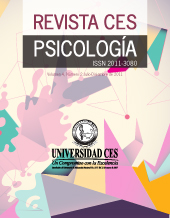Comunicación facial-afectiva y ofertas relacionales verbales durante rupturas y estrategias de resolución: Un estudio sistemático de caso único
DOI:
https://doi.org/10.21615/cesp.13.3.11Palabras clave:
Rupturas, Resoluciones, Comunicación Afectivo-Facial, Ofertas Relacionales, Proceso Psicoterapéutico, Alianza TerapéuticaResumen
La investigación sobre la relación terapéutica ha subrayado su papel central en el proceso de cambio terapéutico, indicando la relevancia de determinar los elementos y mecanismos específicos que intervienen en su configuración (Knobloch-Fedders, Elkin, & Kiesler, 2014). La investigación sobre las rupturas de la relación terapéutica ha aportado a la comprensión del proceso de negociación interpersonal que interviene en la interacción paciente-terapeuta. Aunque estudios anteriores han contribuido a la caracterización objetiva y exhaustiva de las rupturas, se necesitan más investigaciones para especificar los marcadores que permiten comprender el modo como los patrones de regulación afectiva entre paciente y terapeuta están involucrados y contribuyen a la generación de estos eventos y a los intentos de reparación. El objetivo de este estudio es caracterizar el comportamiento facial-afectivo de paciente y terapeuta asociado a las ofertas relacionales (OR) verbales durante los eventos de ruptura (R) y de estrategia de resolución (ER) en una terapia psicodinámica breve. El comportamiento afectivo facial se determinó usando el Facial Action Coding System (FACS), las ORs se derivaron del análisis del contenido de las transcripciones de sesiones, y las R y ER se determinaron usando el 3RS. Se realizaron análisis anidados para establecer asociaciones entre las variables. Los resultados indican la presencia de pautas regulatorias faciales-verbales entre paciente y terapeuta características de las rupturas y estrategias de resolución; y señalan el valor de combinar múltiples enfoques para permitir el acceso a indicadores observables de los procesos regulatorios diádicos que contribuyen a comprender y atender las oscilaciones de la relación terapéutica.
Descargas
Referencias bibliográficas
Altimir, C., &. Jiménez, J.P. (2020). Walking the middle ground between hermeneutics and science: A research proposal on psychoanalytic process. The International Journal of Psychoanalysis, 101(3), 496-522 https://doi.org/10.1080/00207578.2020.1726711
Altimir, C., Krause, M., de la Parra, G., Dagnino, P., Tomicic, A., Valdés, N., … Vilches, O. (2010). Clients', therapists', and observers' agreement on the amount, temporal location, and content of psychotherapeutic change and its relation to outcome. Psychotherapy Research, 20, 4, 472 - 487. https://doi.org/10.1080/10503301003705871
Anstadt, T., Merten, J., Ullrich, B., & Krause, R. (1997). Affective dyadic behavior, core conflictual relationship themes, and success of treatment. Psychotherapy Research, 7, 397-417. https://doi.org/10.1080/10503309712331332103
Aron, L. (1996). A meeting of minds: Mutuality in psychoanalysis. Hillsdale, NJ: Analytic Press.
Bänninger-Huber, E. (1992). Prototypical affective microsequences in psychotherapeutic interaction. Psychotherapy Research, 2, 291-306. https://doi.org/10.1080/10503309212331333044
Bänninger-Huber, E., & Widmer, C. (1999). Affective relationship patterns and psychotherapeutic change. Psychotherapy Research, 9, 74-87. https://doi.org/10.1080/10503309912331332601
Barros, P., Altimir, C., & Pérez, J.C. (2016). Patients’ facial-affective regulation during episodes of rupture of the therapeutic alliance / Regulación afectivo-facial de pacientes durante episodios de ruptura de la alianza terapéutica. Estudios de Psicología, 37, 2-3, 580-603. https://doi.org/10.1080/02109395.2016.1204781
Benecke, C., & Krause, R. (2005). Facial affective relationship offers of patients with panic disorder. Psychotherapy Research, 15, 178-187. https://doi.org/10.1080/10503300512331335048
Benecke, C., Peham, D., & Bänninger-Huber, E. (2005). Nonverbal relationship regulation in psychotherapy. Psychotherapy Research, 15, 81-90. https://doi.org/10.1080/10503300512331327065
Castonguay, L.G., Goldfried, M.R., Wiser, S., Raue, P.J., & Hayes, A.M. (1996). Predicting the effect of cognitive therapy for depression: A study of unique and common factors. Journal of Consulting and Clinical Psychology, 64, 497-504. https://doi.org/10.1037/0022-006X.64.3.497
Coutinho, J., Ribeiro, E., Fernandes, C., Sousa, I., & Safran, J. D. (2014). The development of the therapeutic alliance and the emergence of alliance ruptures. Anales de Psicología, 30(3), 985–994. http://dx.doi.org/10.6018/analesps.30.3.168911
Coutinho, J., Ribeiro, E., Hill, C., & Safran, J. D. (2011). Therapists’ and clients’ experiences of alliance ruptures: A qualitative study. Psychotherapy Research, 21(5), 525–540. http://dx.doi.org/10.1080/10503307.2011.587469
de la Parra, G., von Bergen, A., & del Río, M. (2002). Primeros hallazgos de la aplicación de un instrumento que mide resultados psicoterapéuticos en una muestra de pacientes y de población general. Revista Chilena de Neuropsiquiatría, 40, 201-209. http://dx.doi.org/10.4067/S0717-92272002000300003
Dreher, M., Mengele., U., Krause, R., & Kämmerer, A. (2001). Affective indicators of the psychotherapeutic process: An empirical case study. Psychotherapy Research, 11, 99-117. https://doi.org/10.1080/713663855
Ekman, P. (1979). About brows: Emotional and conversational signals. In M von Cranach, K. Foppa, W. Lepenies and D. Ploog (Eds.) (pp. 169-249). Human Ethology. Cambridge, UK: Cambridge University Press.
Ekman, P., & Friesen, W. V. (1978). Facial action coding system: A technique for the measurement of facial movement. Palo Alto, California: Consulting Psychologists Press.
Ekman, P., & Friesen, W. V. (1982). Felt, false, and miserable smiles. Journal of Nonverbal Behavior, 6(4), 238-252. https://doi.org/0191-5886/82/1400-0238
Eubanks, C. F., Muran, J. C., & Safran, J. D. (2015). Rupture Resolution Rating System (3RS): Manual. Technical Report.
Fleiss, J. L., Levin, B., & Cho Paik, M. (1981). Statistical Methods for Rates and Proportions. (3rd. ed). New York: John Wiley & Sons.
Fonagy, P., & G. Moran, (1993). Selecting Single Case Research Designs for Clinicians. In E. N. Miller, L. Luborsky, J. P. Barber, and J. P. Docherty (Eds.). Psychodynamic Treatment Research: A Handbook for Clinical Practice (pp. 62–95). New York: Basic Books.
Horvath, A. O., Del Re, A. C., Flückiger, C., & Symonds, D. (2011). Alliance in individual psychotherapy. Psychotherapy, 48, 9–16. https://doi.org/10.1037/a0022186
Kächele, H. (2020). From case study to single case research: The specimen case Amalia X. In M. Leuzinger-Bohleber, M. Solms, & S. E. Arnold (Eds.). Outcome research and the future of psychoanalysis. Clinicians and researchers in dialogue. (pp. 68-88). New York: Routledge.
Knobloch-Fedders, L. M., Elkin, I., & Kiesler, D.J. (2015). Looking Back, looking Forward: A historical reflection on psychotherapy process research. Psychotherapy Research 25(4), 383–395. https://doi.org/10.1080/10503307.2014.906764
Krause, M., Altimir, C., Pérez, C., & de la Parra, G. (2014). Generic Change Indicators in therapeutic processes with different outcomes. Psychotherapy Research, 25(5), 533-545. https://doi.org/10.1080/10503307.2014.935516.
Krause, M., de la Parra, G., Arístegui, R., Dagnino, P., Tomicic, A., Valdés, N., … Ramírez, M.L. (2007). The evolution of therapeutic change studied through generis change indicators. Psychotherapy Research, 17, 673-689. https://doi.org/10.1080/10503300601158814
Krause, R., & Merten, J. (1999). Affects, Regulation of Relationship, Transference and Countertransference. International Forum of Psychoanalysis, 8, 103-114. https://doi.org/10.1080/080370699436429
Lambert, M. J., Hansen, N. B., Umpress, V., Lunnen, K., Okiishi, J., & Burlingame, G. M. (1996). Administration and scoring manual for the OQ-45.2. Wilmington, DE: American Professional Credentialing Services.
Merten, J. (1997). Facial-affective behavior, mutual gaze, and emotional experience. Journal of Nonverbal Behavior, 21(3), 179-201. https://doi.org/10.1023/A:1024969514170
Merten, J. (2005). Facial microbehavior and the emotional quality of the therapeutic relationship. Psychotherapy Research, 15, 325-333. https://doi.org/10.1080/10503300500091272
Mitchell, S.A. (1988). Relational concepts in psychoanalysis. Cambridge, MA: Harvard University Press.
Norcross, J. C. (2011). Psychotherapy relationships that work: Evidence based responsiveness (2nd ed.). New York: Oxford University Press. https://doi.org/10.1093/acprof:oSo/9780199737208.001.0001
Piper, W.E., Azim, H.F.A., Joyce, A.S., & McCallum, M. (1991). Transference interpretations, therapeutic alliance, and outcome in short term individual psychotherapy. Archives of General Psychiatry, 48, 946-953. http://doi.org/10.1001/archpsyc.1991.01810340078010
Rasting, M., & Beutel, M. (2005). Dyadic affective interactive patterns in the intake interview as a predictor of outcome. Psychotherapy Research, 15(3), 188-198. https://doi.org/10.1080/10503300512331335039
Raudenbush, S. W., Bryk, A. S., Cheong, Y., Congdon, R., & du Toit, M. (2004). HLM6: Linear and non-linear modeling. Chicago: Scientific Software International.
Rozmarin, E., Muran, J. C., Safran, J., Gorman, B., Nagy, J., & Winston, A. (2008). Subjective and intersubjective analyses of the therapeutic alliance in a brief relational therapy. American Journal of Psychotherapy, 62(3), 313-328.
Safran, J. D. (2003). The relational turn, the therapeutic alliance, and psychotherapy research: Strange bedfellows or postmodern marriage? Contemporary Psychoanalysis, 39, 449-475. https://doi.org/10.1080/00107530.2003.10747215
Safran, J. D., & Kraus, J. (2014). Alliance ruptures, impasses, and enactments: A relational perspective. Psychotherapy, 51, 381–387. https://doi.org/10.1037/a0036815
Safran, J. D., & Muran, J, Ch. (2000). Negotiating the therapeutic alliance. A relational treatment guide. New York: The Guilford Press.
Safran, J. D., & Muran, J. Ch. (2006). Has the concept of the therapeutic alliance outlived its usefulness? Psychotherapy: Theory, Research, Practice, Training, 43, 286-291. https://doi.org/10.1037/0033-3204.43.3.286
Safran, J. D., Muran, J. C., Samstag, L. W., & Winston, A. (2005). Evaluating alliance-focused intervention for potential treatment failures: A feasibility study and descriptive analysis. Psychotherapy: Theory, Research, Practice, Training, 42(4), 512–531. https://doi.org/10.1037/0033-3204.42.4.512
Sayette, M. A., Cohn, J. F., Wertz, J. M., Perrott, M. A., & Parrott, D. J. (2001). A psychometric evaluation of the Facial Action Coding System for assessing spontaneous expression. Journal of Nonverbal Behavior, 25(3), 167 - 185. https://doi.org/10.1023/A:1010671109788
Descargas
Publicado
Cómo citar
Número
Sección
Licencia
Derechos de autor 2020 CES Psicología

Esta obra está bajo una licencia internacional Creative Commons Atribución-SinDerivadas 4.0.
Revista CES Psicología ISSN 2011 3080
Facultad de Psicología, Universidad CES Primera edición 2008. Última actualización Mayo 18 de 2022. Todos los derechos reservados. Hecho el depósito legal que exige la ley.
Se autoriza la reproducción total o parcial de los artículos citando la fuente y el autor. This publication may be reproduced by mentioning the source and the authors.
| Estadísticas de artículo | |
|---|---|
| Vistas de resúmenes | |
| Vistas de PDF | |
| Descargas de PDF | |
| Vistas de HTML | |
| Otras vistas | |




